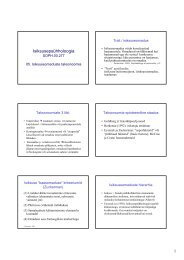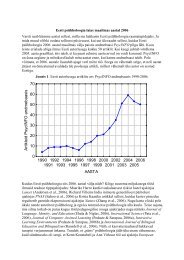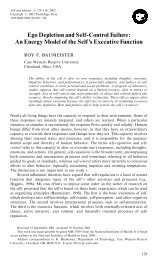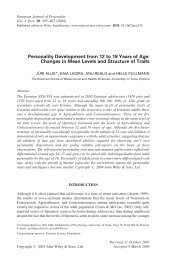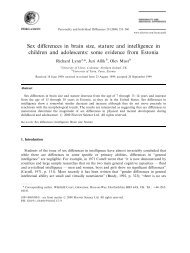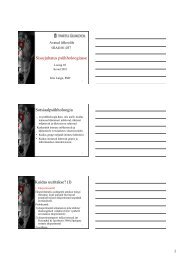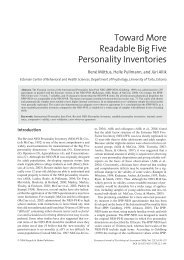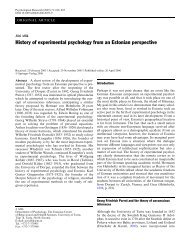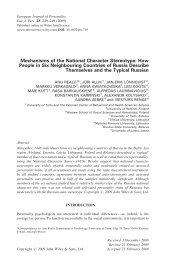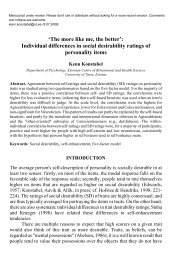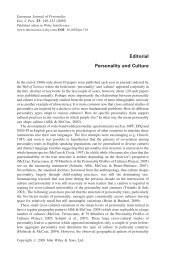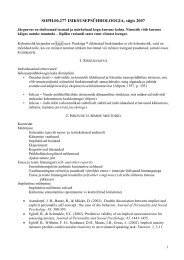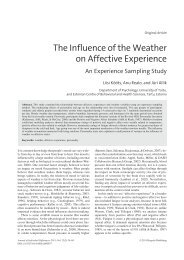Economic inequality is linked to biased self-perception
Economic inequality is linked to biased self-perception
Economic inequality is linked to biased self-perception
Create successful ePaper yourself
Turn your PDF publications into a flip-book with our unique Google optimized e-Paper software.
Psychological Science<br />
http://pss.sagepub.com/<br />
<strong>Economic</strong> Inequality Is Linked <strong>to</strong> Biased Self-Perception<br />
Steve Loughnan, Peter Kuppens, Jüri Allik, Katalin Balazs, Soledad de Lemus, Kitty Dumont, Rafael Gargurevich, Istvan<br />
Hidegkuti, Bernhard Leidner, Lennia Ma<strong>to</strong>s, Joonha Park, Anu Realo, Junqi Shi, Vic<strong>to</strong>r Eduardo Sojo, Yuk-yue Tong,<br />
Jeroen Vaes, Philippe Verduyn, Vic<strong>to</strong>ria Yeung and Nick Haslam<br />
Psychological Science 2011 22: 1254 originally publ<strong>is</strong>hed online 23 September 2011<br />
DOI: 10.1177/0956797611417003<br />
The online version of th<strong>is</strong> article can be found at:<br />
http://pss.sagepub.com/content/22/10/1254<br />
Publ<strong>is</strong>hed by:<br />
http://www.sagepublications.com<br />
On behalf of:<br />
Association for Psychological Science<br />
Additional services and information for Psychological Science can be found at:<br />
Email Alerts: http://pss.sagepub.com/cgi/alerts<br />
Subscriptions: http://pss.sagepub.com/subscriptions<br />
Reprints: http://www.sagepub.com/journalsReprints.nav<br />
Perm<strong>is</strong>sions: http://www.sagepub.com/journalsPerm<strong>is</strong>sions.nav<br />
>> Version of Record - Oct 6, 2011<br />
Proof - Sep 23, 2011<br />
What <strong>is</strong> Th<strong>is</strong>?<br />
Downloaded from pss.sagepub.com at Tartu Ulikooli Raamatukogu on Oc<strong>to</strong>ber 30, 2011
Research Report<br />
<strong>Economic</strong> Inequality Is Linked <strong>to</strong><br />
Biased Self-Perception<br />
Psychological Science<br />
22(10) 1254 –1258<br />
© The Author(s) 2011<br />
Reprints and perm<strong>is</strong>sion:<br />
sagepub.com/journalsPerm<strong>is</strong>sions.nav<br />
DOI: 10.1177/0956797611417003<br />
http://pss.sagepub.com<br />
Steve Loughnan 1,2 , Peter Kuppens 1,3 , Jüri Allik 4,5 , Katalin Balazs 6 ,<br />
Soledad de Lemus 7 , Kitty Dumont 8 , Rafael Gargurevich 9 , Istvan<br />
Hidegkuti 6 , Bernhard Leidner 10 , Lennia Ma<strong>to</strong>s 9 , Joonha Park 1,11 ,<br />
Anu Realo 4 , Junqi Shi 12 , Vic<strong>to</strong>r Eduardo Sojo 13 , Yuk-yue Tong 14 ,<br />
Jeroen Vaes 15 , Philippe Verduyn 3 , Vic<strong>to</strong>ria Yeung 16 , and<br />
Nick Haslam 1<br />
1 University of Melbourne; 2 University of Kent; 3 University of Leuven; 4 University of Tartu; 5 Es<strong>to</strong>nian Academy of Sciences,<br />
Tallinn, Es<strong>to</strong>nia; 6 University of Debrecen; 7 Universidad de Granada; 8 University of South Africa; 9 Universidad Peruana<br />
de Ciencias Aplicadas; 10 University of Massachusetts, Amherst; 11 University of Tokyo; 12 Peking University;<br />
13 Universidad Central de Venezuela; 14 Singapore Management University; 15 University of Padova; and 16 University of Hokkaido<br />
Abstract<br />
People’s <strong>self</strong>-<strong>perception</strong> biases often lead them <strong>to</strong> see themselves as better than the average person (a phenomenon known<br />
as <strong>self</strong>-enhancement). Th<strong>is</strong> bias varies across cultures, and variations are typically explained using cultural variables, such as<br />
individual<strong>is</strong>m versus collectiv<strong>is</strong>m. We propose that socioeconomic differences among societies—specifically, relative levels<br />
of economic <strong>inequality</strong>—play an important but unrecognized role in how people evaluate themselves. Evidence for <strong>self</strong>enhancement<br />
was found in 15 diverse nations, but the magnitude of the bias varied. Greater <strong>self</strong>-enhancement was found in<br />
societies with more income <strong>inequality</strong>, and income <strong>inequality</strong> predicted cross-cultural differences in <strong>self</strong>-enhancement better<br />
than did individual<strong>is</strong>m/collectiv<strong>is</strong>m. These results indicate that macrosocial differences in the d<strong>is</strong>tribution of economic goods<br />
are <strong>linked</strong> <strong>to</strong> microsocial processes of perceiving the <strong>self</strong>.<br />
Keywords<br />
<strong>self</strong>-<strong>perception</strong>, <strong>self</strong>-enhancement, income <strong>inequality</strong>, culture, <strong>self</strong>-esteem, sociocultural fac<strong>to</strong>rs, socioeconomic status<br />
Received 1/5/11; Rev<strong>is</strong>ion accepted 6/5/11<br />
People often d<strong>is</strong>play a rosy bias in their <strong>self</strong>-<strong>perception</strong>. Th<strong>is</strong><br />
<strong>self</strong>-enhancement bias <strong>is</strong> the tendency <strong>to</strong> emphasize or exaggerate<br />
one’s desirable qualities relative <strong>to</strong> other people’s (Alicke,<br />
1985; Guenther & Alicke, 2010). The magnitude of th<strong>is</strong> bias<br />
varies across cultures, with people reporting higher levels of<br />
<strong>self</strong>-enhancement in some nations (e.g., the United States) than<br />
in others (e.g., Japan). These variations have been subject <strong>to</strong><br />
extensive cross-cultural examination and debate centering on<br />
whether the desire <strong>to</strong> <strong>self</strong>-enhance <strong>is</strong> common <strong>to</strong> all people<br />
(Sedikides, Gaertner, & Toguchi, 2003; Sedikides, Gaertner, &<br />
Vevea, 2007) or stronger among Westerners, particularly North<br />
Americans, than among Easterners (Heine, 2003; Heine,<br />
Kitayama, & Hamamura, 2007; Heine, Lehman, Markus, &<br />
Kitayama, 1999). In a recent meta-analys<strong>is</strong>, Heine et al. (2007)<br />
found that 79 of 81 studies showed that Westerners were significantly<br />
more likely <strong>to</strong> <strong>self</strong>-enhance than Easterners.<br />
The prevailing explanation of cross-cultural variability in<br />
levels of <strong>self</strong>-enhancement invokes the cultural dimensions of<br />
individual<strong>is</strong>m and collectiv<strong>is</strong>m (Boucher, 2010; Chiu, Wan,<br />
Cheng, Kim, & Yang, 2010; Triand<strong>is</strong>, 1995) and the associated<br />
concepts of independence and interdependence (Heine et al.,<br />
1999; Oyserman, Coon, & Kemmelmeier, 2002). Theor<strong>is</strong>ts<br />
argue that Westerners are more likely <strong>to</strong> be individual<strong>is</strong>ts who<br />
seek personal success and uniqueness, and thus <strong>self</strong>-enhance<br />
more than do Easterners, who are more likely <strong>to</strong> be collectiv<strong>is</strong>ts<br />
seeking interpersonal harmony and belonging (Boucher,<br />
2010; Heine & Hamamura, 2007). We propose an alternative<br />
explanation that favors socioeconomic differences over cultural<br />
dimensions. We suggest that the extent <strong>to</strong> which people<br />
engage in <strong>biased</strong> <strong>self</strong>-<strong>perception</strong> <strong>is</strong> influenced by the economic<br />
Corresponding Author:<br />
Steve Loughnan, University of Kent, Canterbury, Kent CT2 7NZ, United<br />
Kingdom<br />
E-mail: s.loughnan@kent.ac.uk<br />
Downloaded from pss.sagepub.com at Tartu Ulikooli Raamatukogu on Oc<strong>to</strong>ber 30, 2011
<strong>Economic</strong> Inequality and Biased Self-Perception 1255<br />
structure of their society, specifically its level of economic<br />
<strong>inequality</strong>.<br />
Societies differ in their degree of economic <strong>inequality</strong>. In<br />
unequal societies, wealth <strong>is</strong> concentrated at the <strong>to</strong>p, d<strong>is</strong>advantage<br />
at the bot<strong>to</strong>m <strong>is</strong> extreme, and differences in social standing<br />
are highly salient (Kerbo, 2011; Wilkinson & Pickett,<br />
2010). Accordingly, in unequal societies, individuals are<br />
strongly motivated <strong>to</strong> stand out as superior <strong>to</strong> others. One<br />
expression of th<strong>is</strong> desire may be <strong>to</strong> engage in stronger <strong>self</strong>enhancement.<br />
In societies with more economic equality, the<br />
benefits of superiority dimin<strong>is</strong>h, and people’s tendency <strong>to</strong> see<br />
themselves as above average should weaken. Indirect evidence<br />
that income <strong>inequality</strong> may be <strong>linked</strong> <strong>to</strong> <strong>self</strong>-enhancement<br />
comes from ex<strong>is</strong>ting cross-cultural research. Japan and the<br />
United States—pro<strong>to</strong>typical collectiv<strong>is</strong>t and individual<strong>is</strong>t<br />
nations, respectively—also markedly differ on income equality.<br />
Among developed nations, Japan <strong>is</strong> one of the most equal<br />
and the United States <strong>is</strong> one of the least equal (Wilkinson &<br />
Pickett, 2010). The reliable difference in levels of <strong>self</strong>enhancement<br />
observed between these two nations may be a<br />
function not only of individual<strong>is</strong>m versus collectiv<strong>is</strong>m, but<br />
also of covarying differences in each society’s degree of economic<br />
equality.<br />
Income <strong>inequality</strong> may foster greater <strong>self</strong>-enhancement<br />
through increased competition. Takata (2003) found that when<br />
Japanese participants were asked <strong>to</strong> compete over a limited<br />
resource under zero-sum conditions (i.e., the winner receives<br />
everything, the loser nothing), they d<strong>is</strong>played levels of <strong>self</strong>enhancement<br />
similar <strong>to</strong> the levels d<strong>is</strong>played by Americans.<br />
That <strong>is</strong>, when people compete over concentrated rewards, they<br />
have a tendency <strong>to</strong> <strong>self</strong>-enhance. Because economic <strong>inequality</strong><br />
polarizes benefits and costs and emphasizes hierarchy, people<br />
living in societies with high income <strong>inequality</strong> may see social<br />
relations as similar <strong>to</strong> zero-sum competitions. Thus, people in<br />
such societies should be particularly prone <strong>to</strong> <strong>self</strong>-enhancement,<br />
independent of levels of individual<strong>is</strong>m.<br />
The role of socioeconomic fac<strong>to</strong>rs in understanding crosscultural<br />
differences has been increasingly recognized by<br />
researchers (Kitayama & Uskul, 2011; Oyserman & Lee,<br />
2008). Demographic and economic differences between societies<br />
(e.g., population size, market integration) are predictive<br />
of social relationships. Socioeconomic differences explain<br />
cross-cultural variation in the extent <strong>to</strong> which people cooperate,<br />
exploit, and pun<strong>is</strong>h others (Henrich, Ensminger, et al.,<br />
2010; Marlowe et al., 2008). Although recent work has <strong>linked</strong><br />
differences in social relations <strong>to</strong> socioeconomic fac<strong>to</strong>rs,<br />
researchers have not examined how these differences might be<br />
related <strong>to</strong> <strong>perception</strong>s of the <strong>self</strong>. We contributed <strong>to</strong> th<strong>is</strong> emerging<br />
field by examining the association between economic<br />
<strong>inequality</strong> and <strong>biased</strong> <strong>self</strong>-<strong>perception</strong>.<br />
In the study reported here, we investigated whether socioeconomic<br />
differences might be related <strong>to</strong> <strong>biased</strong> <strong>self</strong>-<strong>perception</strong>.<br />
Specifically, we expected economically unequal societies <strong>to</strong><br />
be associated with an increased tendency <strong>to</strong> see the <strong>self</strong> as better<br />
than others (<strong>self</strong>-enhancement). We expected the effect of<br />
income <strong>inequality</strong> <strong>to</strong> be d<strong>is</strong>tinct from and more powerful than<br />
the effect of cultural differences in individual<strong>is</strong>m and<br />
collectiv<strong>is</strong>m.<br />
Method<br />
We gathered data from 1,625 participants in five continents<br />
and 15 nations: Europe (Belgium, Es<strong>to</strong>nia, Germany,<br />
Hungary, Italy, Spain), the Americas (Peru, the United States,<br />
Venezuela), Asia (China, Japan, Singapore, South Korea),<br />
Africa (South Africa), and Oceania (Australia). In 14 countries,<br />
participants were recruited from student populations at<br />
universities; in the United States, nonstudent participants were<br />
recruited online. Participants either volunteered, received<br />
course credit, or received payment. The samples varied in size<br />
(n = 80–260 per country), and participants were predominantly<br />
young (mean age = 21.55 years, SD = 5.80 years), with more<br />
females (67%) than males (33%).<br />
Participants completed a standard questionnaire assessing<br />
<strong>self</strong>-enhancement. All questionnaires were translated in<strong>to</strong> the<br />
native languages of the participants and back-translated for<br />
equivalence. The questionnaire asked participants <strong>to</strong> rate a set<br />
of personality traits and values on two dimensions. The first<br />
dimension, “How much do you possess th<strong>is</strong> character<strong>is</strong>tic<br />
compared <strong>to</strong> the average student” (or “How much do you possess<br />
th<strong>is</strong> character<strong>is</strong>tic compared <strong>to</strong> the average person” in the<br />
U.S. sample), was rated on a 7-point scale ranging from 1,<br />
much less than the average student/person, <strong>to</strong> 7, much more<br />
than the average student/person. The second dimension, “Th<strong>is</strong><br />
character<strong>is</strong>tic <strong>is</strong> desirable, it <strong>is</strong> a character<strong>is</strong>tic that people generally<br />
want,” was rated on a 7-point scale ranging from 1,<br />
not at all, <strong>to</strong> 7, very much so. The traits were selected on<br />
the bas<strong>is</strong> of previous research <strong>to</strong> cover all domains of the<br />
Schwartz Value Survey (Schwartz, 1992) and the Big Five<br />
personality fac<strong>to</strong>rs (Haslam, Bain, Douge, Lee, & Bastian,<br />
2005; Loughnan et al., 2010). For each language, four versions<br />
of the questionnaires were prepared. Participants randomly<br />
received one version. The questions on each version were<br />
identical, but the traits that participants were asked <strong>to</strong> rate differed.<br />
To reduce the amount of time required <strong>to</strong> complete the<br />
questionnaire, we included only 20 personality traits and values<br />
on each version, and th<strong>is</strong> resulted in 80 personality traits<br />
and values being rated across the sample.<br />
Societal indices were compiled from freely available<br />
sources. National levels of individual<strong>is</strong>m, collectiv<strong>is</strong>m, and<br />
power d<strong>is</strong>tance (the extent <strong>to</strong> which people prefer an au<strong>to</strong>cratic<br />
hierarchy versus a relative equality of power) were drawn<br />
from previous work (Hofstede, 2001). To assess economic<br />
<strong>inequality</strong>, we used national Gini coefficients, which gauge the<br />
income d<strong>is</strong>tribution within a society; as calculated by the<br />
United Nations, a Gini value of 100 means that a single individual<br />
receives all of the income (perfect <strong>inequality</strong>), and a<br />
Gini value of 0 means that income <strong>is</strong> evenly d<strong>is</strong>tributed across<br />
the population (perfect equality). Thus, higher values indicate<br />
greater <strong>inequality</strong>. Gini values were taken from the United<br />
Downloaded from pss.sagepub.com at Tartu Ulikooli Raamatukogu on Oc<strong>to</strong>ber 30, 2011
1256 Loughnan et al.<br />
Nations Human Development Report (United Nations Human<br />
Development Programme, 2010).<br />
Results<br />
Data were analyzed using multilevel modeling. Two-level<br />
multilevel regression models (with traits nested in persons)<br />
were estimated <strong>to</strong> obtain an average and separate random<br />
intercept and slope value for each nation. Three-level models<br />
(with traits nested in persons nested in nations) were estimated<br />
<strong>to</strong> examine the moderating role of income <strong>inequality</strong> and individual<strong>is</strong>m/collectiv<strong>is</strong>m<br />
in <strong>self</strong>-enhancement. Both age and<br />
gender significantly moderated <strong>self</strong>-enhancement (age: b =<br />
0.003, p = .044; gender: b = –0.05, p < .001), and thus, all<br />
subsequent analyses controlled for these fac<strong>to</strong>rs. Since 72 participants<br />
failed <strong>to</strong> report age or gender, the <strong>to</strong>tal number of<br />
participants was reduced <strong>to</strong> 1,553 individuals.<br />
Self-enhancement was measured by regressing <strong>self</strong>-ratings<br />
on<strong>to</strong> trait desirability. Th<strong>is</strong> approach allows for individual and<br />
cultural differences independent of the relationship between<br />
<strong>self</strong>-ratings and desirability of traits. If people <strong>self</strong>-enhance,<br />
they should rate desirable qualities as especially <strong>self</strong>-descriptive<br />
relative <strong>to</strong> the average person (Guenther & Alicke, 2010). In a<br />
two-level model predicting <strong>self</strong>-report from trait desirability<br />
and controlling for age and gender at the person level, a significant<br />
<strong>self</strong>-enhancement effect was found across nations using<br />
dummy-coded variables for each nation at the person level<br />
(b = 0.24, p < .001). Further, a significant <strong>self</strong>-enhancement<br />
effect was found within every nation (all ps < .022). Cons<strong>is</strong>tent<br />
with the findings of prior research, our results showed that<br />
there was considerable variability between nations (bs =<br />
0.07–0.42).<br />
Next, national Gini coefficients were included at the nation<br />
level in a three-level model. As income <strong>inequality</strong> increased,<br />
people’s tendency <strong>to</strong> <strong>self</strong>-enhance also increased (b = 0.01, p =<br />
.002). Next, we included individual<strong>is</strong>m/collectiv<strong>is</strong>m alongside<br />
the Gini coefficients. In th<strong>is</strong> model, income <strong>inequality</strong><br />
remained a significant predic<strong>to</strong>r of <strong>self</strong>-enhancement (b =<br />
0.01, p = .001), and individual<strong>is</strong>m did not significantly predict<br />
levels of <strong>self</strong>-enhancement above income <strong>inequality</strong> (b <<br />
–0.001, p = .331). Moreover, Gini coefficients were significantly<br />
better predic<strong>to</strong>rs of <strong>self</strong>-enhancement than individual<strong>is</strong>m<br />
and collectiv<strong>is</strong>m were, χ 2 (1) = 25.40, p < .001. A model with<br />
Gini coefficient and individual<strong>is</strong>m/collectiv<strong>is</strong>m performed<br />
better than a model with individual<strong>is</strong>m/collectiv<strong>is</strong>m only,<br />
χ 2 (2) = 15.94, p < .001. By contrast, adding individual<strong>is</strong>m/<br />
collectiv<strong>is</strong>m <strong>to</strong> a model containing only Gini coefficients did<br />
not result in a significant improvement, χ 2 (2) = 0.05, p > .500.<br />
These results indicate that, in th<strong>is</strong> sample, income <strong>inequality</strong><br />
was more important for explaining cross-national differences<br />
in levels of <strong>self</strong>-enhancement than individual<strong>is</strong>m/collectiv<strong>is</strong>m<br />
were. For example, in comparing Venezuelans (high collectiv<strong>is</strong>m,<br />
high income <strong>inequality</strong>) with Japanese (high collectiv<strong>is</strong>m,<br />
low income <strong>inequality</strong>) in a two-level model with dummycoded<br />
nation variables, the former showed much higher levels<br />
of <strong>self</strong>-enhancement than did the latter (b = 0.40 vs. b = 0.07,<br />
respectively).<br />
We also investigated the influence of another cultural variable,<br />
power d<strong>is</strong>tance, which may be more closely <strong>linked</strong> <strong>to</strong><br />
economic <strong>inequality</strong> than individual<strong>is</strong>m and collectiv<strong>is</strong>m are. 1<br />
Power d<strong>is</strong>tance captures the extent <strong>to</strong> which people prefer<br />
an au<strong>to</strong>cratic hierarchy versus a relative equality of power<br />
(Hofstede, 2001). When power-d<strong>is</strong>tance scores were included<br />
in the three-level model, Gini coefficients remained significant<br />
predic<strong>to</strong>rs of <strong>self</strong>-enhancement (b = 0.01, p = .001), but<br />
individual<strong>is</strong>m/collectiv<strong>is</strong>m (b < 0.001, p = 0.513) and power<br />
d<strong>is</strong>tance (b < 0.001, p = .986) did not.<br />
There was a significant positive relationship between Gini<br />
coefficients and <strong>self</strong>-enhancement at the national level, r(15) =<br />
.79, p < .001. As expected, people see themselves as superior<br />
<strong>to</strong> others <strong>to</strong> a greater extent in societies with a higher level of<br />
income <strong>inequality</strong> (Fig. 1). To investigate whether the observed<br />
positive prediction of <strong>self</strong>-rating by trait desirability reflected<br />
the belief that the <strong>self</strong> was indeed better than others, we<br />
selected the 20 most desirable traits in each nation. We then<br />
conducted a single-sample t test for each nation <strong>to</strong> test whether<br />
the mean <strong>self</strong>-rating score for the 20 most desirable traits differed<br />
from the scale midpoint of 4 (which was labeled as neither<br />
less nor more than the average student/person). In 14 of<br />
the 15 nations, the average <strong>self</strong>-rating was indeed significantly<br />
higher than the scale midpoint for these desirable traits (all<br />
ps < .01). Only Japanese participants failed <strong>to</strong> rate these traits<br />
significantly above the scale midpoint, t(19) = 1.36, p = .19,<br />
although the mean was in the anticipated direction (M = 4.12).<br />
In short, people typically viewed themselves as better than<br />
average.<br />
D<strong>is</strong>cussion<br />
The tendency for people <strong>to</strong> believe they possess more desirable<br />
character<strong>is</strong>tics than others appears widespread. It was observed<br />
in 15 nations spanning all developed continents. It <strong>is</strong> important<br />
<strong>to</strong> note that the magnitude of th<strong>is</strong> <strong>self</strong>-enhancing bias varied<br />
according <strong>to</strong> societal differences in economic <strong>inequality</strong>. In<br />
societies with less income <strong>inequality</strong>, people showed a relatively<br />
weak bias compared with people in societies with more<br />
income <strong>inequality</strong>. It appears that people in societies with more<br />
income <strong>inequality</strong> tend <strong>to</strong> view themselves as superior <strong>to</strong> others,<br />
and people in societies with less income <strong>inequality</strong> tend <strong>to</strong> see<br />
themselves as more similar <strong>to</strong> their peers.<br />
Socioeconomic differences accounted for the variability in<br />
th<strong>is</strong> bias better than did individual<strong>is</strong>m/collectiv<strong>is</strong>m, the cultural<br />
dimensions that have guided most previous research.<br />
Th<strong>is</strong> finding does not invalidate the utility of individual<strong>is</strong>m/<br />
collectiv<strong>is</strong>m for thinking about cultural differences. Indeed,<br />
these dimensions capture many East-West differences in <strong>self</strong>and<br />
other <strong>perception</strong>, including <strong>self</strong>-enhancement (for recent<br />
reviews, see Heine & Hamamura, 2007; Kitayama & Uskul,<br />
2011; Oyserman & Lee, 2008). Our research emphasizes<br />
the importance of considering material differences between<br />
Downloaded from pss.sagepub.com at Tartu Ulikooli Raamatukogu on Oc<strong>to</strong>ber 30, 2011
<strong>Economic</strong> Inequality and Biased Self-Perception 1257<br />
0.45<br />
0.40<br />
Venezuela<br />
Peru<br />
Self-Enhancement<br />
0.35<br />
0.30<br />
0.25<br />
0.20<br />
0.15<br />
Singapore<br />
Spain<br />
Hungary<br />
United States<br />
Australia China<br />
Korea Italy Es<strong>to</strong>nia<br />
South Africa<br />
0.10<br />
0.05<br />
Japan<br />
Belgium<br />
Germany<br />
0<br />
20 25 30 35 40 45 50 55 60<br />
<strong>Economic</strong> Inequality (Gini coefficient)<br />
Fig. 1. Scatter plot (with best-fitting regression line) showing <strong>self</strong>-enhancement (as indexed by beta<br />
weights from a two-level model) as a function of economic <strong>inequality</strong> (as indexed by the Gini coefficient)<br />
across nations. The data points for Australia and Italy are very close and overlap on the graph.<br />
societies—particularly the d<strong>is</strong>tribution of income—when<br />
examining psychological differences. Th<strong>is</strong> emphas<strong>is</strong> <strong>is</strong> cons<strong>is</strong>tent<br />
with recent suggestions that people may respond <strong>to</strong> social<br />
and material conditions when <strong>self</strong>-enhancing (von Hippel &<br />
Trivers, 2011).<br />
It <strong>is</strong> unlikely that economic <strong>inequality</strong> directly leads <strong>to</strong><br />
<strong>biased</strong> <strong>self</strong>-<strong>perception</strong>. It seems more likely that there are<br />
intervening fac<strong>to</strong>rs that result from socioeconomic differences.<br />
One possibility ra<strong>is</strong>ed earlier <strong>is</strong> perceived competition<br />
(Takata, 2003). When benefits and costs are polarized by<br />
<strong>inequality</strong>, people may compete for social superiority (Kerbo,<br />
2011; Wilkinson & Pickett, 2010). One manifestation of<br />
th<strong>is</strong> drive may be the presentation of the <strong>self</strong> as superior<br />
through <strong>self</strong>-enhancement. Thus, it may be the competitiveness<br />
triggered by economic <strong>inequality</strong> that drives <strong>biased</strong> <strong>self</strong><strong>perception</strong>.<br />
It <strong>is</strong> interesting <strong>to</strong> note that competitiveness may<br />
be related <strong>to</strong> differences in individual<strong>is</strong>m as well, with more<br />
individual<strong>is</strong>tic societies also fostering greater competition<br />
(Chen & West, 2008; Green, Deschamps, & Paez, 2005). Both<br />
individual<strong>is</strong>m and economic <strong>inequality</strong> may work in concert <strong>to</strong><br />
foster a <strong>perception</strong> of competition that results in cultural differences<br />
in levels of <strong>self</strong>-enhancement. 1 Likew<strong>is</strong>e, both individual<strong>is</strong>m<br />
and economic <strong>inequality</strong> may undermine the norm<br />
of modesty. Modesty norms play an important role in reducing<br />
<strong>self</strong>-enhancement, and when they are comprom<strong>is</strong>ed, <strong>self</strong>enhancement<br />
increases (Kurman, 2003, 2010). In societies<br />
with more income equality, people may not only have moreequal<br />
incomes, but they may also feel a pressure <strong>to</strong> seem more<br />
similar <strong>to</strong> others. Th<strong>is</strong> may manifest as a modesty norm,<br />
whereby people are d<strong>is</strong>couraged from voicing both real and<br />
perceived superiority. Understanding the relationship between<br />
socioeconomic structure and individual psychology can help<br />
bridge the gulf between large-scale sociological studies of<br />
societies and individual social and psychological functioning.<br />
An important limitation of our study should be noted. 1 With<br />
the exception of the U.S. sample, our participants were drawn<br />
from university populations. Participant selection can seriously<br />
affect research findings (Henrich, Heine, & Norenzayan,<br />
2010), and our selection of university students might be confounded<br />
with levels of social <strong>inequality</strong>. University students<br />
might often find themselves in situations in which their social<br />
standing <strong>is</strong> actually better than the average person’s, an effect<br />
which would be more pronounced in societies with more<br />
income <strong>inequality</strong>. Although we tried <strong>to</strong> guard against th<strong>is</strong><br />
confound by having participants compare themselves with the<br />
average student, a more robust test of whether economic<br />
<strong>inequality</strong> influences <strong>self</strong>-enhancement would involve sampling<br />
participants from groups receiving the median income in<br />
a society and examining their levels of <strong>self</strong>-enhancement.<br />
In sum, cultural differences in <strong>self</strong>-<strong>perception</strong> have been<br />
the subject of extensive psychological research. The prevailing<br />
explanation of these differences has focused on the cultural<br />
dimensions of individual<strong>is</strong>m and collectiv<strong>is</strong>m. In contrast,<br />
in the research reported in th<strong>is</strong> article, we examined whether<br />
socioeconomic fac<strong>to</strong>rs play a more important but unrecognized<br />
role in <strong>self</strong>-<strong>perception</strong>. It appears that aspects of macrolevel<br />
socioeconomic organization may be reflected in<br />
microlevel <strong>self</strong>-<strong>perception</strong>.<br />
Declaration of Conflicting Interests<br />
The authors declared that they had no conflicts of interest with<br />
respect <strong>to</strong> their authorship or the publication of th<strong>is</strong> article.<br />
Downloaded from pss.sagepub.com at Tartu Ulikooli Raamatukogu on Oc<strong>to</strong>ber 30, 2011
1258 Loughnan et al.<br />
Funding<br />
Steve Loughnan <strong>is</strong> a postdoc<strong>to</strong>ral research associate funded by the<br />
Leverhulme Trust (F/00236/W). Peter Kuppens <strong>is</strong> a postdoc<strong>to</strong>ral<br />
research fellow with the Fund for Scientific Research-Flanders and <strong>is</strong><br />
supported by Katholieke Universiteit Leuven Research Council<br />
Grants GOA/05/04 and OT/11/031. Anu Realo and Jüri Allik were<br />
supported by a grant from the Es<strong>to</strong>nian Min<strong>is</strong>try of Education and<br />
Science (SF0180029s08). Junqi Shi was supported by a grant from<br />
the National Nature Foundation of China (NSFC:71021001).<br />
Note<br />
1. We thank an anonymous reviewer for th<strong>is</strong> suggestion.<br />
References<br />
Alicke, M. (1985). Global <strong>self</strong>-evaluation as determined by the desirability<br />
and controllability of trait adjectives. Journal of Personality<br />
and Social Psychology, 49, 1621–1630.<br />
Boucher, H. (2010). Understanding Western-East Asian differences<br />
and similarities in <strong>self</strong>-enhancement. Social & Personality Psychology<br />
Compass, 4, 304–317.<br />
Chen, F., & West, S. (2008). Measuring individual<strong>is</strong>m and collectiv<strong>is</strong>m:<br />
The importance of considering differential components, reference<br />
groups, and measurement invariance. Journal of Research<br />
in Personality, 42, 259–294.<br />
Chiu, C.-Y., Wan, C., Cheng, S., Kim, Y.-H., & Yang, Y.-J.<br />
(2010). Cultural perspectives on <strong>self</strong>-enhancement and <strong>self</strong>protection.<br />
In M. Alicke & C. Sedikides (Eds.), Handbook of <strong>self</strong>enhancement<br />
and <strong>self</strong>-protection (pp. 425–446). New York, NY:<br />
Guilford Press.<br />
Green, E., Deschamps, J., & Paez, D. (2005). Variation of individual<strong>is</strong>m<br />
and collectiv<strong>is</strong>m within and between 20 countries. Journal of<br />
Cross-Cultural Psychology, 36, 321–339.<br />
Guenther, C., & Alicke, M. (2010). Deconstructing the better-thanaverage<br />
effect. Journal of Personality and Social Psychology, 99,<br />
755–770.<br />
Haslam, N., Bain, P., Douge, L., Lee, M., & Bastian, B. (2005). More<br />
human than you: Attributing humanness <strong>to</strong> <strong>self</strong> and others. Journal<br />
of Personality and Social Psychology, 89, 937–950.<br />
Heine, S. J. (2003). An exploration of cultural variation in <strong>self</strong>enhancing<br />
and <strong>self</strong>-improving motivations. In V. Murphy-Berman<br />
& J. Berman (Eds.), Nebraska Symposium on Motivation: Vol. 49.<br />
Cross-cultural differences in perspectives on the <strong>self</strong> (pp. 101–128).<br />
Lincoln: University of Nebraska Press.<br />
Heine, S. J., & Hamamura, T. (2007). In search of East Asian <strong>self</strong>enhancement.<br />
Personality and Social Psychology Review, 11, 4–27.<br />
Heine, S. J., Kitayama, S., & Hamamura, T. (2007). Inclusion of additional<br />
studies yields different conclusions: Comment on Sedikides,<br />
Gaertner, & Vevea (2005), Journal of Personality and Social Psychology.<br />
Asian Journal of Social Psychology, 10, 49–58.<br />
Heine, S. J., Lehman, D., Markus, H., & Kitayama, S. (1999). Is there<br />
a universal need for positive <strong>self</strong>-regard? Psychological Review,<br />
106, 766–794.<br />
Henrich, J., Ensminger, J., McElreath, R., Barr, A., Barrett, C.,<br />
Bolyanatz, A., . . . Ziker, J. (2010). Markets, religion, community<br />
size, and the evolution of fairness and pun<strong>is</strong>hment. Science, 327,<br />
1480–1484.<br />
Henrich, J., Heine, S. J., & Norenzayan, A. (2010). The weirdest<br />
people in the world? Behavioral & Brain Sciences, 33, 61–83.<br />
Hofstede, G. (2001). Culture’s consequences: Comparing values, behaviors,<br />
institutions, and organizations across nations (2nd ed.).<br />
Thousand Oaks, CA: Sage.<br />
Kerbo, H. (2011). Social stratification and <strong>inequality</strong> (8th ed.). New<br />
York, NY: McGraw-Hill.<br />
Kitayama, S., & Uskul, A. (2011). Culture, mind, and the brain: Current<br />
evidence and future directions. Annual Review of Psychology, 62,<br />
419–449.<br />
Kurman, J. (2003). Why <strong>is</strong> <strong>self</strong>-enhancement low in certain collectiv<strong>is</strong>tic<br />
cultures? An investigation of two competing explanations.<br />
Journal of Cross-Cultural Psychology, 34, 496–510.<br />
Kurman, J. (2010). Good, better, best: Between culture and <strong>self</strong>enhancement.<br />
Social & Personality Psychology Compass, 4, 379–<br />
392.<br />
Loughnan, S., Leidner, B., Doron, G., Haslam, N., Kashima, Y.,<br />
Tong, J., & Yeung, V. (2010). Universal biases in <strong>self</strong>-<strong>perception</strong>:<br />
Better and more human than average. Brit<strong>is</strong>h Journal of Social<br />
Psychology, 49, 627–636.<br />
Marlowe, F., Berbesque, J. C., Barr, A., Barrett, C., Bolyanatz, A.,<br />
Cardenas, J., . . . Tracer, D. (2008). More altru<strong>is</strong>tic pun<strong>is</strong>hment in<br />
larger societies. Proceedings of the Royal Society B: Biological<br />
Sciences, 275, 587–590.<br />
Oyserman, D., Coon, H., & Kemmelmeier, M. (2002). Rethinking<br />
individual<strong>is</strong>m and collectiv<strong>is</strong>m: Evaluation of theoretical assumptions<br />
and meta-analyses. Psychological Bulletin, 128, 3–72.<br />
Oyserman, D., & Lee, S. (2008). Does culture influence what and<br />
how we think? Effects of priming individual<strong>is</strong>m and collectiv<strong>is</strong>m.<br />
Psychological Bulletin, 134, 311–342.<br />
Schwartz, S. (1992). Universals in the content and structure of values:<br />
Theoretical advances and empirical tests in 20 countries. In<br />
M. P. Zanna (Ed.), Advances in experimental social psychology<br />
(Vol. 25, pp. 1–65). Orlando, FL: Academic Press.<br />
Sedikides, C., Gaertner, L., & Toguchi, Y. (2003). Pancultural <strong>self</strong>enhancement.<br />
Journal of Personality and Social Psychology, 84,<br />
60–79.<br />
Sedikides, C., Gaertner, L., & Vevea, J. (2007). Evaluating the evidence<br />
for pancultural <strong>self</strong>-enhancement. Asian Journal of Social<br />
Psychology, 10, 201–203.<br />
Takata, T. (2003). Self-enhancement and <strong>self</strong>-critic<strong>is</strong>m in Japanese<br />
culture: An experimental analys<strong>is</strong>. Journal of Cross-Cultural<br />
Psychology, 34, 542–551.<br />
Triand<strong>is</strong>, H. (1995). Individual<strong>is</strong>m and collectiv<strong>is</strong>m. San Franc<strong>is</strong>co,<br />
CA: Westview Press.<br />
United Nations Human Development Programme. (2010). Human<br />
Development Report 2010. New York, NY: Author.<br />
von Hippel, W., & Trivers, R. (2011). The evolution and psychology<br />
of <strong>self</strong>-deception [Target article and commentary]. Behavioral &<br />
Brain Sciences, 34, 1–56.<br />
Wilkinson, R., & Pickett, K. (2010). The spirit level: Why equality <strong>is</strong><br />
better for everyone. London, England: Penguin.<br />
Downloaded from pss.sagepub.com at Tartu Ulikooli Raamatukogu on Oc<strong>to</strong>ber 30, 2011



